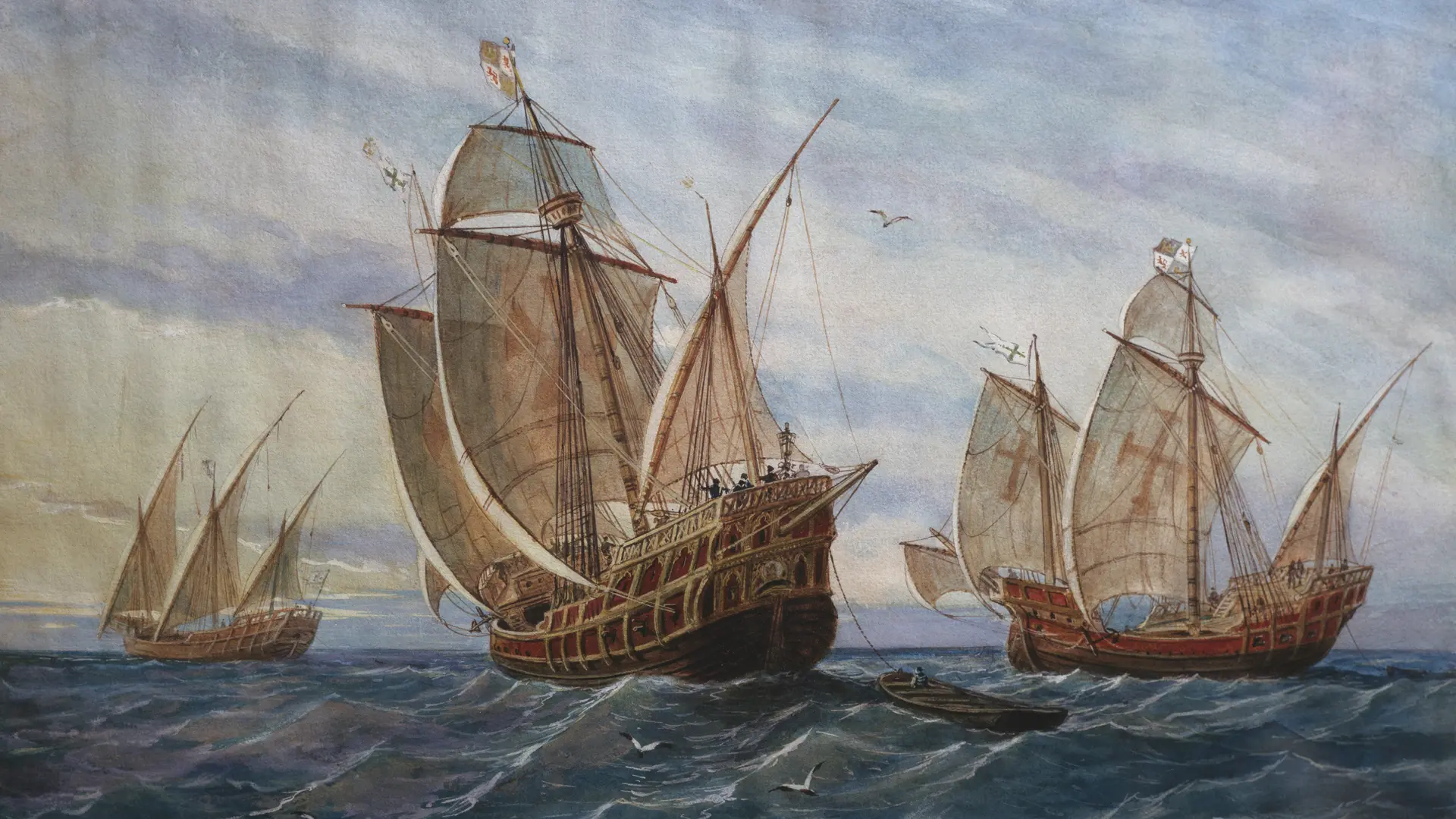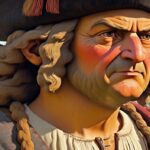Have you heard of a dinghy named caravel? It’s like a plain fishing boat. Well, what if you hear that from a dinghy, this caravel turned into the mean machine of the sea? Yeah, not figuratively, but literally, with the top-notch changes made in its design. This made it the go-to ship for legendary explorers like Vasco da Gama and Christopher Columbus. Their journeys on this beast changed how the world was connected, opening a brand-new era of exploration. The caravel may have just been a small fishing boat, but it became the ship that linked continents and brought us into a whole new world of sea travel.
A Humble Ship That Changed the World
You’ve probably heard of Christopher Columbus and Vasco da Gama, right? These daring explorers sailed across vast oceans, discovering new lands and forever changing the course of history. But have you ever wondered how they did it? The answer, in part, lies in a ship called the caravel.
Think of the caravel as the sporty, adaptable cousin of the clunky ships that sailed the seas before. It wasn’t just one magic improvement but a combination of clever design choices that made the caravel the perfect ship for the Age of Exploration.
The Caravel’s Secret Weapon
Let’s break down the caravel’s winning formula, piece by piece:
1. The Power of the Triangle: Lateen Sails
Imagine trying to sail against the wind – it’s like trying to walk up an escalator going down! This was a major headache for sailors until the caravel adopted the lateen sail. This triangular sail, borrowed from Arab ships called dhows, allowed caravels to sail almost into the wind. This newfound agility opened up navigation possibilities, making long voyages and exploration possible.
2. The Shallow Secret: A Hull for All Occasions
Unlike the bulky ships of the time, the caravel had a shallow hull, meaning it didn’t sit deep in the water. This was a game-changer for exploration. It allowed caravels to navigate shallow coastal waters and even venture up rivers, bringing explorers closer to new lands and potential trading partners.
3. Best of Both Worlds: A Winning Sail Plan
The caravel was a master of adaptation, sporting both lateen and square sails. Think of it like this: the square sails were like a powerful engine, propelling the ship forward when the wind was favorable. But when the wind shifted, the nimble lateen sails took over, ensuring the caravel could maneuver in almost any conditions.
More Than Just a Pretty Hull: The Caravel’s Lasting Impact
The caravel’s design wasn’t just about looking good; it had a profound impact on the world:
- Opening the Globe: The Age of Exploration
The caravel’s ability to travel vast distances and reach previously inaccessible areas fueled the Age of Exploration. Explorers set sail with greater confidence, leading to the discovery of new sea routes, continents, and cultures.
- Spices and Treasures: Global Trade Routes
The caravel wasn’t just about exploration; it was a floating marketplace. With its increased cargo capacity and ability to navigate diverse waters, the caravel established new trade routes, connecting Europe to the riches of Asia and beyond.
- Small but Mighty: A Surprisingly Capable Warship
Though not as large as dedicated warships, the caravel’s speed and agility made it surprisingly effective in naval battles. Its maneuverability allowed it to outmaneuver larger, slower opponents, making it a valuable asset in naval conflicts.
- A Symbol of Ingenuity: The Legacy of the Caravel
Today, the caravel remains an enduring symbol of exploration, innovation, and the human desire to push boundaries. Its distinct silhouette evokes a sense of adventure and serves as a reminder of how a relatively simple ship helped to reshape our understanding of the world.
Little Ship, Big Changes: The Caravel’s Enduring Legacy
The caravel’s story is a testament to the power of human ingenuity. It reminds us that sometimes, the most impactful innovations arise from taking something ordinary and improving upon it with a few key changes. The caravel’s legacy extends far beyond its time as a ship; it stands as a symbol of exploration, trade, and the interconnectedness of our world.
Outperforming the Competition: What Improvements Were Made to the Caravel?
We’ve already talked about how groundbreaking caravels were, but let’s dive into the details of what made them such game-changers on the open ocean. What exactly did these shipbuilders tweak and refine to make the caravel the ultimate exploration vessel?
Riding the Wind with Lateen Sails
Imagine you’re a sailor back in the 15th century, stuck with clunky square sails that only let you go in one direction – with the wind. Frustrating, right? Enter the lateen sail, a brilliant invention borrowed from Arab sailors. This triangular sail, perched on a long, angled yardarm, was a game-changer. It was like giving the caravel the ability to zig-zag, sailing closer to the wind than anyone thought possible. Suddenly, the wind wasn’t a limitation, it was an advantage.
Sneaking Through Shallow Waters
The caravel was a master of disguise, at least when it came to its draft – the depth of the ship below the waterline. This ship was designed to ride high, with a shallow draft that allowed it to navigate rivers and hug coastlines like a pro. This was huge for explorers, as it meant they could slip into uncharted territories, explore rivers deep inland, and even surprise unsuspecting folks on the shore.
A Smooth Operator: The Caravel Hull
Ever notice how some boats just seem to glide through the water? A lot of that has to do with the hull – the body of the ship. The caravel used a special technique called carvel-building, where wooden planks were placed edge-to-edge, creating a smooth, streamlined surface. This minimized drag, meaning the caravel could cut through the water with less resistance, making it faster and more efficient. Plus, it probably looked pretty sleek out on the high seas.
A Ship for Every Occasion
The best part about the caravel? It was incredibly adaptable. It wasn’t a one-size-fits-all kind of ship. Smaller caravels, nicknamed “caravels latinas,” were perfect for darting along coastlines and hauling in fish. Then you had the bigger “caravels redondas,” built for long-haul voyages across the vast Atlantic. These beefier caravels could carry tons of cargo – everything from spices and silks to, unfortunately what we now know was a horrific practice, enslaved people.
Charting a New Course in History
All these innovations added up to one thing: the caravel was the perfect tool for exploration. It was fast, maneuverable, and could slip into places other ships could only dream of. It’s no surprise that Portuguese and Spanish explorers chose this ship to venture down the African coast, conquer the treacherous Cape of Good Hope, and eventually, bump into the Americas. Without the caravel, who knows what the world map would look like today!
Caravels: A Legacy of Innovation
To sum it up, the caravel was more than just a ship – it was a symbol of human ingenuity. The innovations made to its design – from the powerful lateen sails to the cleverly designed hull – revolutionized seafaring and enabled explorers to connect the world in ways never thought possible. It’s a reminder that sometimes, all it takes is a few tweaks and a whole lot of courage to change the course of history.
Unlocking the Secrets of the Caravel: A Deep Dive into its Significance
The caravel, a marvel of maritime engineering, revolutionized exploration with its blend of speed, maneuverability, and windward sailing capabilities. But what was the single most significant advancement that set this ship apart? Was it the innovative lateen sails or its shallow draft that unlocked new horizons in the Age of Discovery?
A Closer Look at the Lateen Sails
Imagine a sail, not as a simple square catching the wind, but as a triangle, cleverly angled to harness even the slightest breeze. That’s the lateen sail – the caravel’s secret weapon. Unlike the square sails of its predecessors, the lateen sail allowed caravels to sail closer to the wind, a technique known as “tacking.” This meant they were no longer limited to following the wind’s direction but could actually zigzag their way forward, even against prevailing winds. This dramatically increased their agility and opened up possibilities for exploration that were previously unimaginable.
The Impact of a Shallow Hull
The caravel’s shallow draft, meaning the depth of its hull below the waterline, might seem like a small detail, but it was a game-changer. This design feature allowed caravels to navigate shallow coastal waters and rivers with ease. While larger ships were confined to deep water ports, caravels could slip into uncharted territories, explore inland waterways, and establish trading posts in locations that were inaccessible to their bulkier counterparts.
Combining Innovation for Greatest Impact
However, to pinpoint just one advancement as the most significant would be a disservice to the caravel’s ingenious design. It was the synergy of these innovations—the lateen sails, the shallow hull, the sturdy yet relatively lightweight construction—that made the caravel such a revolutionary vessel. It was more than just a fast ship; it was adaptable, capable of both coastal exploration and transatlantic voyages, forever changing the world.
A Legacy of Exploration and Beyond
While later overshadowed by larger cargo vessels, the caravel’s legacy as the vessel of discovery remains undisputed in maritime history. Its ability to sail closer to the wind, navigate shallow waters, and cover vast distances with surprising speed made it the perfect tool for explorers, traders, and even naval strategists of the time.
Unlocking the Secrets of the Caravel’s Maneuverability
The caravel’s ability to navigate with such agility wasn’t solely due to one magic feature but rather a combination of intelligent design choices. These innovations, often borrowed and adapted from earlier shipbuilding traditions, worked together to create a vessel that could outmaneuver and outperform its contemporaries.
The Power of the Sternpost Rudder
One of the most significant improvements to the caravel was the adoption of the sternpost rudder. Unlike earlier steering oar systems, which were cumbersome and less effective, the sternpost rudder was a game-changer. Mounted on the centerline of the stern, this rudder provided superior control, allowing for tighter turns and greater responsiveness. This innovation, likely borrowed from Arab dhows encountered in the Mediterranean, significantly enhanced the caravel’s ability to navigate challenging waters and maintain course in open ocean conditions.
The Lateen Sail Advantage
The caravel’s signature lateen sails were more than just aesthetically pleasing; they were a key factor in its maneuverability. These triangular sails, often adapted from Arab designs, could be adjusted to catch the wind from various angles. This flexibility allowed caravels to sail closer to the wind, a technique known as “tacking,” which was essential for exploration. It meant they could make progress against the wind, exploring areas previously inaccessible to ships reliant on following the wind’s direction.
Compact Size, Maximum Agility
The caravel’s relatively small size and shallow draft played a crucial role in its agility. This allowed for quick turns and easy handling, especially in confined spaces or when navigating rivers and estuaries. Unlike larger ships of the time that struggled in shallow waters, the caravel could move with grace and precision, exploring hidden coves, navigating narrow passages, and even being rowed when wind conditions were unfavorable.
The Legacy of Maneuverability
The caravel’s maneuverability made it the ideal vessel for the Age of Exploration, but its impact extended far beyond that era. The innovations that made it so agile influenced later ship designs, contributing to the development of even more efficient and maneuverable vessels. The caravel’s story reminds us that sometimes, the smallest tweaks combined with ingenuity can lead to the most significant advancements, changing the course of history and shaping the world we know today.
How the Caravel Revolutionized Global Trade
Before the 15th century, global trade was a slow and arduous process, often limited by land routes controlled by intermediaries or treacherous sea voyages on vessels ill-equipped for long distances. However, the emergence of the caravel changed all that, ushering in a new era of maritime trade and connecting continents in ways never before possible.
Overcoming Obstacles to Trade
European powers, eager to access the riches of the East, faced considerable challenges. Traditional land routes were often controlled by empires like the Ottomans and Persians, adding cost and complexity. Existing ships were slow, expensive to operate, and ill-suited for sailing against prevailing winds, making exploration and return voyages challenging.
Prince Henry the Navigator of Portugal spearheaded the effort to find a solution. He assembled experts in navigation, cartography, and shipbuilding at Sagres, Portugal, a center dedicated to maritime innovation. This led to the development of the caravel, a ship specifically designed to overcome the challenges of long-distance exploration and trade.
The Caravels Defining Features:
- Lateen Sails: The caravel’s triangular lateen sails were revolutionary. They allowed for sailing windward, a technique known as tacking, enabling ships to sail against the wind and return from distant lands.
- Shallow Draft: The caravel’s shallow draft, the depth of the hull below the waterline, allowed it to navigate shallow coastal waters and rivers. This opened up new possibilities for establishing trading posts in locations inaccessible to larger vessels.
- Maneuverability: The caravel was easy to maneuver, even in tight spaces, making it ideal for exploring unfamiliar coastlines and navigating narrow passages.
- Speed: While not the largest ship, the caravel was surprisingly fast and efficient, allowing for quicker voyages and a faster turnaround time for trade.
Opening New Trade Routes and Expanding Possibilities
The caravel’s unique capabilities had a dramatic impact on global trade:
- African Exploration: Portuguese explorers, using caravels, charted the West African coast, establishing trading posts for valuable goods such as gold, ivory, and unfortunately, enslaved people.
- Voyage to India: In 1498, Vasco da Gama, sailing a caravel, reached India by sea. This landmark journey opened a direct sea route to Asia, bypassing the traditional land routes and their associated costs and challenges. Spices, silks, and porcelain flooded into Europe, challenging existing trade monopolies and transforming the European economy.
- Connecting to the Americas: While Columbus’s initial voyages utilized larger ships, caravels like the Niña and the Pinta played crucial roles in exploring the Caribbean and South America. This opened up trade in new goods like tobacco, sugar, and silver, reshaping global trade patterns.
The Caravel’s Impact and Enduring Legacy
The caravel’s impact on trade extended far beyond the immediate exchange of goods. It fueled the growth of port cities like Lisbon, Seville, and Amsterdam, transforming them into bustling centers of commerce and cultural exchange. The caravel’s success also spurred further innovation in shipbuilding, leading to the development of larger and more specialized vessels designed for long-distance trade.
Although eventually superseded by larger ships, the caravel’s legacy as an agent of change in global trade is undeniable. It facilitated the exchange of goods, ideas, and cultures on an unprecedented scale, connecting distant corners of the world and laying the groundwork for the interconnected global economy we know today.
- Georgia Platform: A Southern Strategy, 1850s - March 31, 2025
- How many weeks is 40 days: Quick Conversion Guide for Accurate Results - March 31, 2025
- How many feet is 300 meters? 984 Feet: Understand Length Conversions Easily - March 31, 2025
















